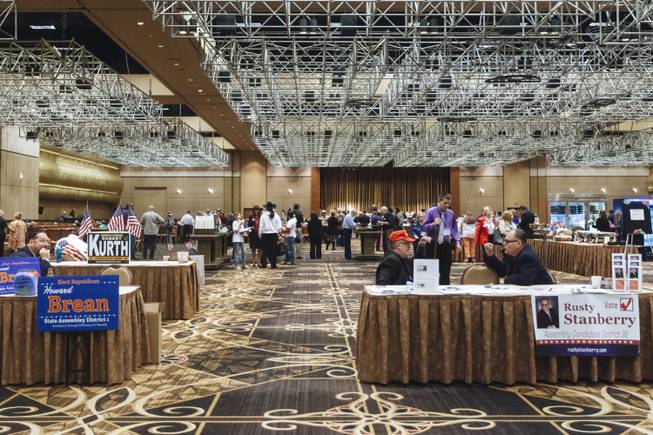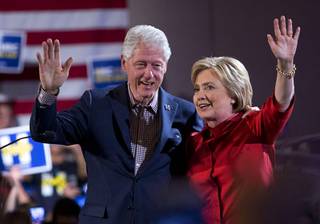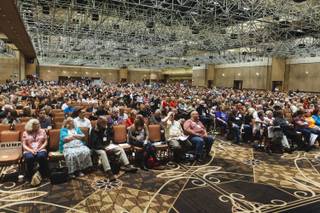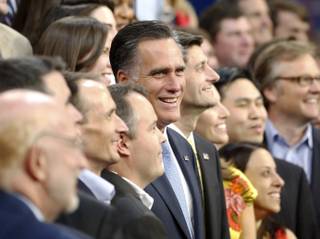
Delegates from the Republican caucuses attend the Clark County Convention to elect representatives to the state convention at the Rio All-Suite Hotel & Casino on Saturday, April 9, 2016..
Monday, May 9, 2016 | 2 a.m.
In a simple world, the candidates with the most votes would win their party’s presidential nomination. But the political world isn’t so simple.
Presidential nominees are selected by their respective parties, so the parties get to set the rules for how those candidates are chosen, and the process varies from state to state.
Nevada has a caucus-convention system. California has a primary system. In Colorado, Republicans held elections at caucus meetings but didn’t cast a presidential preference poll, allowing delegates greater flexibility at the national convention.
The most popular candidate generally wins the nomination, but not always. Talk of an open convention had plagued Republican front-runner Donald Trump for months as some in his party had hoped that one of the other two last candidates in the race — Texas Sen. Ted Cruz or Ohio Gov. John Kasich — would nab the nomination, or a candidate would enter the race during the convention.
That talk essentially ended last week, when Cruz lost the Indiana primary to Trump and suspended his campaign. Kasich, who had won few delegates but maintained he would continue his fight in the hopes of an open convention, dropped out of the race the following day.
Things are slightly less certain on the Democratic side, with Vermont Sen. Bernie Sanders pledging to continue on in his race against former Secretary of State Hillary Clinton after winning Indiana. But Clinton maintains a sizable lead in the delegate count.
Though the battles aren’t technically over, Trump is all but assured the nomination and Clinton has a significant advantage in the Democratic fight. But their paths to victory haven’t always seemed so clear, and the caucus and convention process in Nevada has been tinged with some chaos.
In races where there’s a clear leader, that process matters less. But in a tight race, every step of the process counts. To simplify what has been a confusing few months, here’s a recap of how the caucus and convention process works in Nevada and how it got us to where we are today.
Completed events
• Democratic caucuses, Feb. 20: On caucus day, Democratic voters attended precinct meetings, where they clustered in groups depending on their presidential preference, either for Hillary Clinton or Vermont Sen. Bernie Sanders. Depending on how many people clustered for each candidate, a certain number of delegates was awarded to each candidate at each precinct.
Clinton was awarded 6,440 delegates to county conventions statewide, compared with Sanders’ 5,785. Eight delegates were uncommitted.
In Nevada, 23 of the state’s 43 delegates to the Democratic National Convention are apportioned based on the presidential preference of caucus attendees by congressional district. That means Clinton will receive 13 delegates and Sanders will receive 10.
• Republican caucuses, Feb. 23: Caucus attendees cast ballots in a presidential preference poll to determine the number of delegates the state would send to represent each candidate at the convention. Caucusgoers also elected delegates to their county conventions.
• Democratic county convention: The delegates who were elected at their caucuses attended their county conventions April 2. However, not all of the delegates showed up, allowing alternate delegates to take their seats. Because about 600 more Sanders supporters than Clinton supporters showed up, Sanders had a surprise victory at the Clark County convention.
Statewide, Sanders received 2,124 delegates to the county convention compared with Clinton’s 1,722.
Will that affect the outcome of the state convention? Maybe, but maybe not. The question now is how many of those delegates will turn out to the state convention.
• Republican county convention: Though about 3,200 delegates had been elected on caucus day in Clark County, only about 1,209 delegates showed up to the county convention.
Up to 2,005 delegates were allowed to be sent from the county convention to the state convention, meaning essentially anyone who wants to participate at the state convention and self-nominated at the convention can do so. State convention delegates did not necessarily have to be delegates to the Clark County convention to be valid.
Upcoming events
• Democratic state convention, May 14: At the state convention, 12 delegates are allocated — seven at-large delegates and five others known as PLEO delegates (short for Party Leader and Elected Official). The seven at-large delegates are divvied up based on a party preference vote at the convention. The five PLEO delegates are elected by convention goers.
That means that should the proportion of Sanders to Clinton delegates to the state convention remain the same, Sanders could expect to win four at-large delegates, while Clinton would win three. Of the five PLEO delegates, Sanders would be expected to receive three while Clinton would win two.
Including the delegates assigned based on the caucus-level presidential preference, that would bring the delegate counts to: 18 for Clinton, 17 for Sanders.
However, there also are eight superdelegates that Nevada will send to the Democratic National Convention. So far, four have declared for Clinton, one for Sanders, and the other three haven’t specified their preference. In Clinton's corner are: Sen. Harry Reid, Rep. Dina Titus, state Sen. Ruben Kihuen and Andres Ramirez, vice chairman of the Democratic National Committee's Hispanic Caucus. National committeewoman Erin Bilbray has thrown her support behind Sanders, and the three undecided superdelegates are state party chairwoman Roberta Lange, state party first chair Chris Wicker and DNC at-large member Artie Blanco.
So, as of now, Nevada’s delegate count looks something like this (though the numbers are not set in stone): 22 for Clinton, 18 for Sanders, 3 undecided.
• Republican state convention, May 14: Though the delegate allocation is set, the state convention is where the actual individuals who will represent the state at the national convention are chosen.
That would have been particularly important in the event of a contested convention, which occurs if a candidate fails to reach the delegate threshold on the first round of voting: 1,237. Most delegates to the national convention are bound to vote for a particular candidate on the first ballot, but the majority become unbound if there is a the second ballot, meaning delegates are free to vote for whomever they like.
State rules determine how many votes delegates are bound for, but in Nevada, all of the state’s 30 delegates to the national convention are bound only on the first ballot. (Technically someone could have gone in as a Cruz delegate but switched to Trump on the second ballot.)
But with Cruz and Kasich out of the race, Trump is almost assured to reach the 1,237-vote threshold, thereby eliminating the chance of a contested convention.
Of the 30 delegates selected at the state convention, 12 are selected based on their congressional districts (three from each district), 15 are chosen at-large, and three are members of the Republican National Committee — the national committeeman, committeewoman and state chair.
• Democratic national convention, July 25-28: Those 43 delegates from Nevada will attend the Democratic National Convention in July in Philadelphia. There, they will cast their vote for their chosen candidates.
Unless her trajectory changes, Clinton is expected to clinch the number of delegates needed to win the nomination. Currently, she has 1,683 pledged delegates and 522 superdelegates for a total of 2,205 out of 2,383 delegates needed for the nomination. Sanders, meanwhile, has 1,362 pledged delegates and 39 superdelegates, for a total of 1,401.
Sanders could concede before the convention, as Clinton did to Barack Obama in 2008, though he has indicated that he would not.
• Republican national convention, July 18-21: At the national convention, Nevada’s 30 delegates will vote for their chosen candidates on the first ballot.
Trump is essentially assured to win the Republican nomination and has already declared himself the party’s “presumptive nominee.” Still, he will have to accumulate delegates in the next few contests to reach the 1,237 threshold and officially secure the nomination.
Trump currently has 1,053 delegates, and 514 are still up for grabs. Cruz had 565 and Kasich had 153 when they dropped out of the race.




Join the Discussion:
Check this out for a full explanation of our conversion to the LiveFyre commenting system and instructions on how to sign up for an account.
Full comments policy